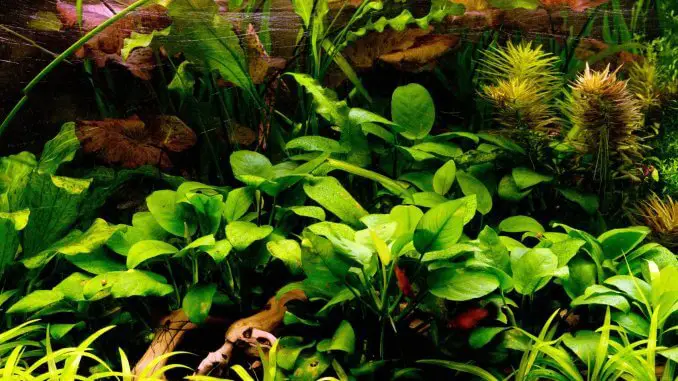
Anubias nana is a short plant with broad leaves. Its dark green colors make it an attractive plant and it will help keep your tank water clean and oxygenated.
Adding plants to an aquarium can be daunting for beginners because it is yet another thing that needs to be looked after. The good news is this species is very hardy and can survive most mistakes that beginners might make.
It’s slow-growing so you don’t need to put much effort into maintaining it, just a trim now and then. It’s easy to propagate too so you can start with a small amount and gradually grow it throughout your tank.
This article will teach you how to care for Anubias nana, including ideal setups, propagation techniques, and much more…
TABLE OF CONTENTS
Anubias Nana Facts & Overview
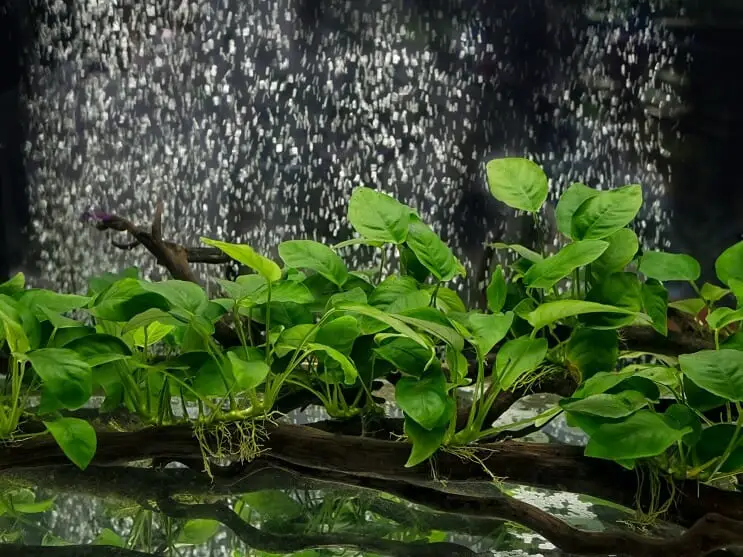
| Category | Rating |
| Family: | Araceae |
| Care Level: | Easy |
| Growth Rate: | Slow |
| Maximum Size: | 7.5 inches |
| Minimum Tank Size: | 10 gallons |
| Water Condition: | 72-82°F, pH 6-7.5, 3-8 KH |
| Lighting: | Low-moderate |
| Propagation: | Rhizome division |
| Placement: | Foreground to background |
Anubias nana (Anubias barteri var. nana) is a variety of the freshwater plant species Anubias barteri, from the Araceae family. Though these are the most common names, it is also sometimes referred to as dwarf Anubias.
A lot of common aquarium plants come from Asia, but this species is native to Africa (Cameroon and Nigeria).
Its hardy nature means it can be kept in a variety of conditions. It can grow both partially or fully submerged, making it popular for a range of aquariums and paludariums.
As one of the shortest plants available, it is ideal for covering the substrate and providing habitats for bottom-dwelling fish (like loaches and catfish). This leaves more free swimming space higher up in the water.
Their leaves are a deep green, adding some attractive color to the bottom of the tank. You shouldn’t have much trouble with propagation either, so it’s cheap and easy to spread this color across your tank.
As well as this, Anubias nana will help to control nitrate levels, remove pollutants and oxygenate the water. Overall this helps to keep the tank healthier and reduces your cleaning workload.
You may have also heard about the Anubias nana petite (Anubias barteri var. nana petite); this is a smaller variant of the Anubias nana and only grows to around 5cm.
Appearance
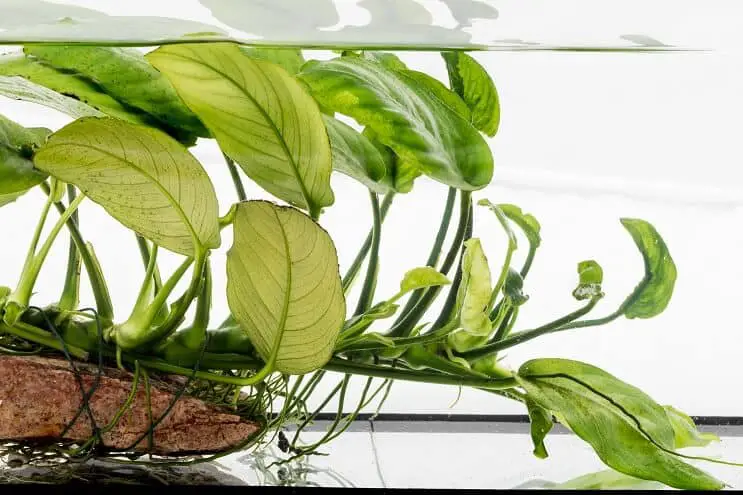
They are a very sturdy plant with a thick, dark green stem. Their maximum height is around 7.5 inches, but size can vary depending on the conditions of the tank.
Since they’re so short they mainly cover the lower levels. Each stem is planted into the substrate and they don’t tend to be floated on the surface. The leaves are dark green and branch off from the stem to take the classic teardrop form found on many plants.
Though each leaf is thin, they’re covered in a cuticle that strengthens them.
Occasionally this plant produces a creamy white flower. They can flower in a paludarium set up where the plant is only partially submerged, but they also flower whilst fully submerged and therefore can make a great focal point plant. The flowers typically last for up to two or three months once they’ve bloomed.
When multiple plants are kept together you can create an impressive display of color that spreads as far as you want it to.
Healthy individuals will have the brightest colors.
White roots anchor the stems in place. They work their way through the substrate as the plant grows, staying buried once planted.
If you don’t want to bury them, you can also attach them to rocks and bogwood as the roots will wrap around them.
Anubias Nana Care
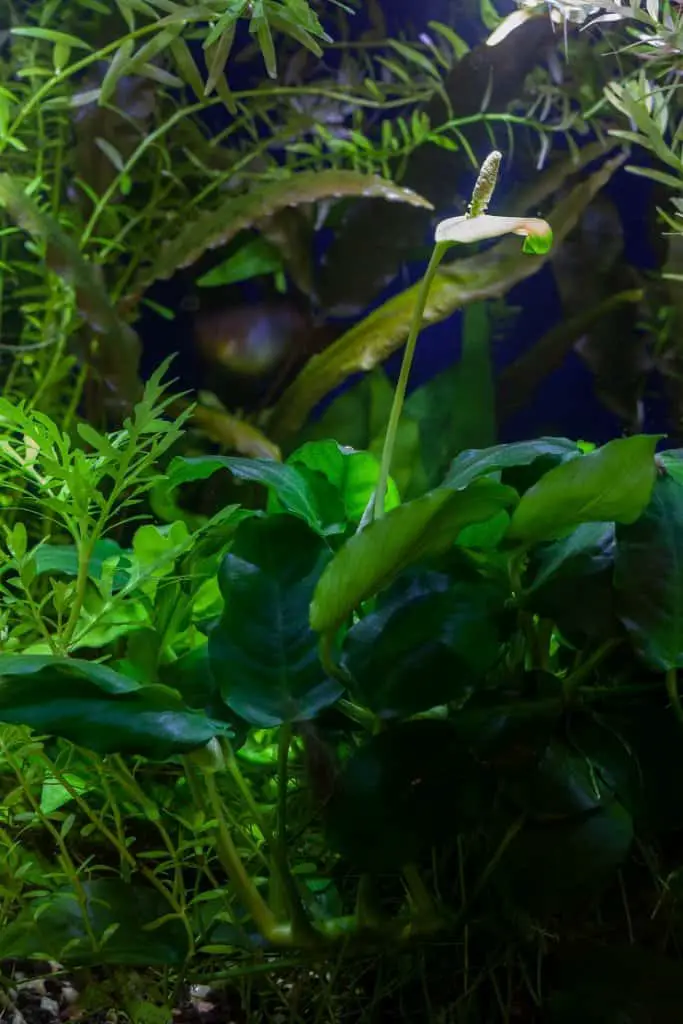
Buying Anubias Nana
When buying your plant, you want the healthiest specimens possible. There are a few things to look out for when picking your plant.
- Color is a key giveaway. Anubias nana is naturally a dark green so if the colors have faded or there are patches of browns or yellows, there is something wrong with the plant.
- The leaves of this species can be heavy, which means having a strong stem is very important. You should avoid any drooping plants that are not able to support their own weight.
- Lastly, check for general damage. Rips in the leaves could limit photosynthesis and slow down growth. Damaged specimens are also less likely to survive once you replant them in the tank.
Since this is a popular species you can find it in most aquarium stores. Its popularity also makes it quite cheap – you can get a healthy plant for less than $5.
Sometimes you’ll find it being sold attached to rocks or bogwood at higher prices.
Tank Requirements
In the wild, you would find Anubias nana planted along river banks, either partially or fully submerged in shallow waters. Here it gets plenty of access to light for photosynthesis.
The substrate would be soft and muddy, making it easy for the roots to grow and take in nutrients from the environment. The water is warm and slightly acidic. These conditions are easy to recreate in a home aquarium.
A heater can be used to keep the water warm. They need a range of 72-82°F, with pH somewhere between 6 and 7.5, and 3-8 KH.
This plant thrives in fine-grained substrates as it allows its roots to grow and anchor them in place.
Sand is the softest, so it is the least likely to damage them.
You don’t need any special lighting, standard aquarium lights will do. Just make sure that the light is reaching the leaves and the plants aren’t in shaded areas. Because of their size you can keep them in small tanks of around 10 gallons.
Maintenance and Care
Anubias nana is a slow-growing species making it one of the easiest plants to maintain.
It will only need trimming every now and then (when the stems get too long).
You need to keep the tank clean, or the buildup of pollutants will gradually become toxic and kill any life in your tank. Regular water changes (every couple of weeks) will control nitrate levels.
Cleaning the tank keeps the water clear too. This makes light more accessible to your plants for photosynthesis.
As the plant grows it takes in nutrients from the water. If there aren’t enough nutrients, its growth will slow down.
If you think this is why your plants aren’t growing then there are plenty of nutrient supplements that you can buy in stores. Another option is to use nutrient-rich substrates. Just be careful that you aren’t adding too many nutrients or you could encourage algae growth.
You can add CO2 for the same effect (since it’s taken in during photosynthesis), but Anubias nana manages with the CO2 expelled by fish as they respire. Adding too much CO2 will harm your fish.
Planting or Floating?
Anubias nana is a planted species, so it won’t do well as a floating plant in the long term.
This species can be planted in the substrate or attached to decorations – the roots will grow and wrap around objects. This lets you add color wherever you want.
It isn’t only decorative though, it provides a habitat for fish. The leaves provide an escape from other boisterous fish and create shaded areas for those looking to get out of the light. Since it’s a planted species, you can choose the location of each plant which helps with aquascaping the tank; this is unlike floating plants that drift around.
If you want a floating plant on the surface then hornwort is a popular, hardy option.
How to Plant Anubias Nana
When planting your Anubias nana, there are a few things to consider.
Don’t plant it in shaded areas. Their leaves need access to light for photosynthesis, without this, they will eventually die.
You need to make sure you leave space between each plant (keep them at least two inches apart). Too many plants in one space with depleted resources, the plants would have to compete, and some will die as a result.
A soft substrate is best for the roots, in the wild they’d be growing through muddy riverbanks. Sand is a good option, but any fine-grained gravel will be ok.
Planting Anubias On Driftwood
Another popular way this plant is used for aquascaping is to attach the Anubias to driftwood. This can be done easily by using a clear fishing line, or fine cotton. Place the plant onto a piece of driftwood, or any other decoration you choose and gently use the cotton to tie the plant in place.
You don’t need to bury the roots, because they will rot if fully buried.
Cotton thread or thin fishing line can be used to help tie the roots to decorations. This will keep them secure until the roots grow strong enough to hold them in place.
After a few weeks, the plants roots will have attached to the surface and you can remove the cotton ties.
How To Propagate Anubias Nana
This species propagates via rhizome division.
Which put simply means that as their stems break off and fall to the substrate, they grow into their own plant.
Using sterilized scissors, take cuttings from fully grown plants. Place these cuttings back into the substrate elsewhere – they’ll soon develop into their own plant. It will only take them a few days to start producing roots.
Each cutting should have at least three leaves so that the new plant can photosynthesis (this is needed for growth).
Don’t take much more from the original plant as it will struggle to survive.
You don’t need to create any special conditions in your tank for propagation, but the plants will grow best when the water is clean and has lots of light, nutrients and CO2.
You can use nutrients and CO2 supplements to optimize this, just make sure to consider the effects they’ll have on any other life in your tank.
Anubias Nana Tank Mates and Compatibility
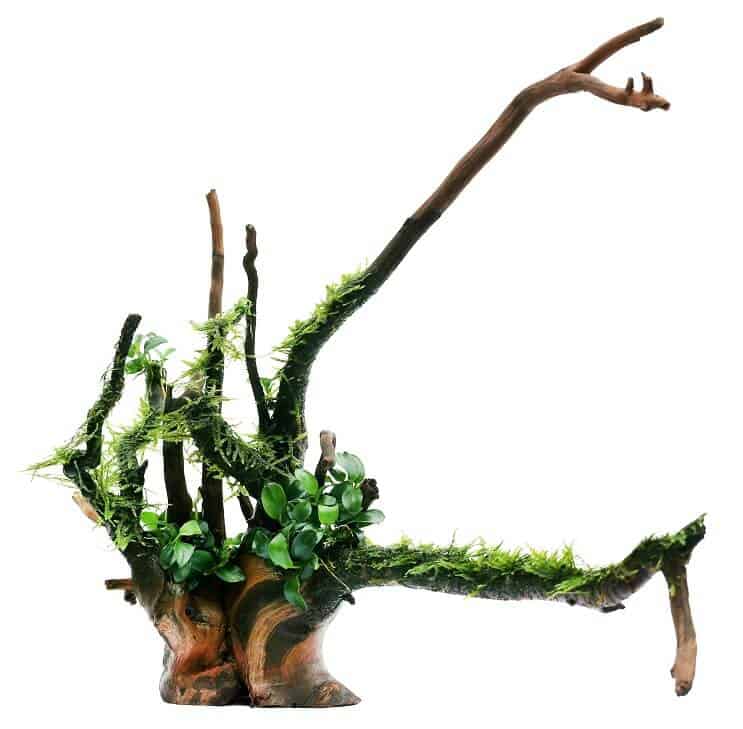
You can keep Anubias nana with pretty much any other aquarium plants, as long as you don’t plant them too densely. Overcrowding will cause resources to run out and some plants will die.
Since this species is short and covers the lower levels of the tank, you could use water sprite to add interest to the middle levels or use hornwort as a float.
Most freshwater fish can be kept with Anubias nana too. Loaches and catfish that live at the bottom of the tank will get the biggest benefit since they can hide amongst the leaves.
The leaves are thin and broad which could lead to damage as fish look for food, so try to avoid species that are prone to nibble. Goldfish are a common example, but lots of other fish are guilty of eating plants too.
These plants can handle small amounts of damage but it’s always best to limit this as much as possible. Research fish before you add them so that you can predict how they’ll act.
Some good tank mates include Yoyo Loaches, Zebra Loaches, Corydoras Catfish, Dwarf Gourami, Mollies, Danios, tetras, Guppies, Cherry Barbs, and even most cichlids.
You have lots of choices which mean you can keep Anubias nana in most freshwater aquariums.
Is Anubias Nana Suitable for your Aquarium? (Summary)
You can keep this plant in a variety of setups – most freshwater tanks are already ideal. As long as your water parameters are within the suitable range, there’s plenty of light, and a soft substrate, then your Anubias nana will thrive.
This plant can be kept with lots of species of fish. However, to avoid excessive damage, stay away from species that are prone to eating plants. Most other popular freshwater fish won’t cause problems.
Another positive with this plant is that it is easy to propagate so you can start with a small amount, take cuttings, and grow some more.
This is a popular option for people of all experience levels because of its hardy nature. If you pick it then you’re unlikely to regret it.
What aquarium setup do you keep your Anubias nana in? Let us know in the comments section below…

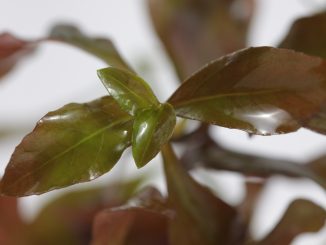
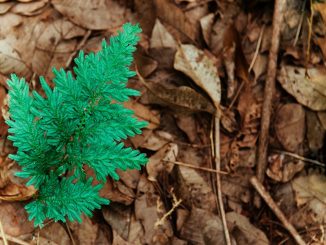
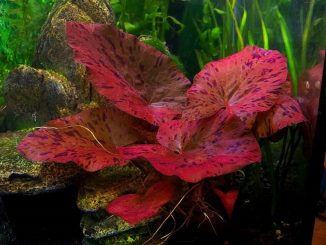
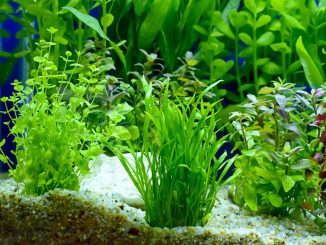
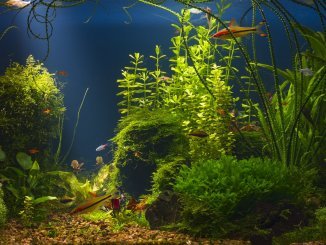
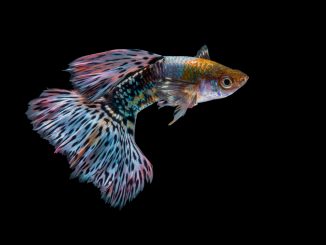
Really enjoyed your article,thankyou.??will look forward to reading others.
I’m a beginner with aquarium plants. These have been very easy for me to grow. Also they don’t melt back.
I have Arabia’s Nana in my tank, it has a growth of Algie, I don’t have the roots in the gravel. The lighting is 30watts, River gravel,set up for 20+yrs, tank depth 45cm,Growth also (I think ) sounded.